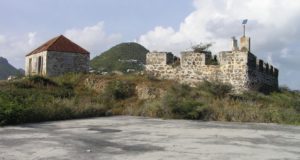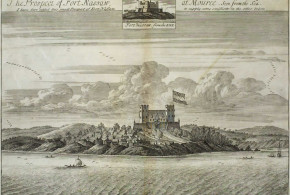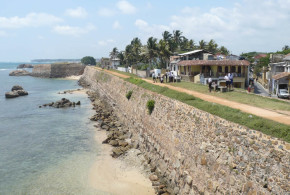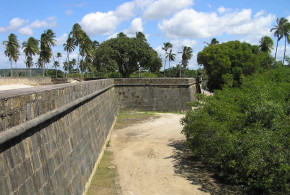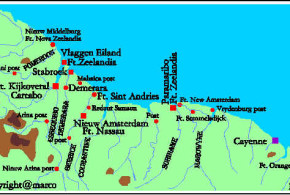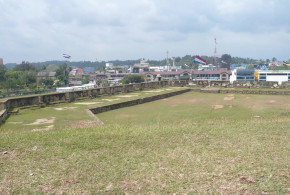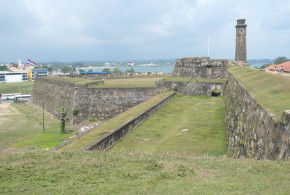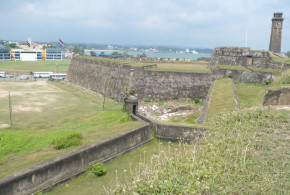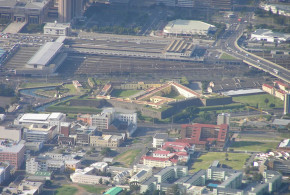Written by Marco Ramerini. English text revision by Dietrich Köster.
YEMEN
Aden:
Netherlands: trading office: August 1620- November/December 1620
On 22 August 1620 the Dutch ship “‘T Wapen van Zeelandt” reached Aden; here the Dutch immediately rented a house. When the ship left Aden, five servants and a supply of goods (worth about 42.000 guilders) were left in the trading post under the charge of the “chief” Harman van Gil. van Gil went to Sana’a, where Muhammad Basha granted the Dutch the permission to build a trading office in Mocha. In November/December 1620 van Gil transferred the Company’s goods to Mocha and closed the trading office in Aden.
Sources: Brouwer, C. G. “The VOC in Yemen, 1614-1655” Amsterdam, 1988 pp. 35-36
Mocha, Mokka (Al Mukha):
Netherlands: trading office: 28 January 1621- April 1623; January 1639- autumn 1639; ? -1739
van Gil arrived in Mocha on 28 January 1621 and there he founded the Dutch trading office. Harman van Gil died in July 1621, Willem Jacobsz. de Milde was appointed “chief” of the trading office. It seems that the trading office was closed in April 1623 due to problems with the Yemenite governors.
In November 1638 a new Dutch expedition reached Mocha, the “assistant” Cornelis van de Graeff was sent to the court in Sana’a asking for a warrant for free trade for the VOC; he returned to Mocha on 9 January 1639 with the warrant, signed by the Imam, that extended the Dutch free access to the entire country of Yemen. Cornelis van de Graeff, Hendrik van Zeller and the “steward” Lucas Ornings with supply of goods (porcelain, spices and sugar) worth about 6.700 guilders were left in Mocha. They, at the close of the trading season, were to cross over to Surat in order to hand over the cash earned to the Dutch director. van de Graeff and van Zeller crossed over to Surat in autumn.
Later the trading office was reopened. Until 1707 Mocha fell under the jurisdiction of the head office in Surat, but thereafter it came under Batavia as an independent base. In 1739 it was closed.
Sources: Brouwer, C. G. “The VOC in Yemen, 1614-1655” Amsterdam, 1988 pp.36, 42-44, 56-60 “Landmonsterrollen, 1691-1790” “Atlas of Mutual Heritage” www.nationaalarchief.nl
Al-Shihr, Sihiri (Ash Shihr):
Netherlands: trading post: September 1614-July 1616
In September 1614, van den Broecke established a small trading post: were stationated here three people: two “assistenten” and one soldier. He appointed Anthoine Claasz. Visser as “hoofd” (chief) of the small Dutch post. In July 1616, the small trading post was closed.
Sources: Brouwer, C. G. “The VOC in Yemen, 1614-1655” Amsterdam, 1988 pp. 22-23, 31
IRAN
Congo, Kung (Band-e Kong):
Netherlands: 1690 ?
In Kong the VOC never had a factory, although for a few months in 1690 it looked as if they would have one.
Sources: Encyclopaedia Iranica (http://iranica.com): “Dutch-Persian Relations” Dam, Pieter van “Beschryvinge van de Oostindische Compagnie (uitgegeven door Dr. F.W. Stapel)” 2e boek, dl.3, p. 289 “Atlas of Mutual Heritage” www.nationaalarchief.nl
Gamron (Bandar-e Abbas):
Netherlands: trading office: (the head office of the VOC’s Persian directorate was located in Gamron from 1638 to 1755): 1623-1758
The VOC founded an office in Gamron in 1623. Here the VOC purchased wool and attar of roses and above all silk. Besides spices and cotton fabrics, the VOC also sold porcelain, opium and Japanese lacquer work. Gamron had a garrison comprising around 20 European employees and 20 Persian staff members. In 1729 the Dutch attempted, without success, to move their factory from Bandar-e Abbas to the island of Hormuz. In 1758 the company decided to close the station at Bandar-e Abbas.
Sources: Encyclopaedia Iranica (http://iranica.com): “Dutch-Persian Relations” “Landmonsterrollen, 1691-1790” “Atlas of Mutual Heritage” www.nationaalarchief.nl
Boucher, Boesjir (Bushehr):
Netherlands: trading post: 1738 -1753
In 1738 the company opened a new trading station in Bushehr.
Sources: Encyclopaedia Iranica (http://iranica.com): “Dutch-Persian Relations” “Landmonsterrollen, 1691-1790” “Atlas of Mutual Heritage” www.nationaalarchief.nl
Spahan, Isfahan (Esfahan):
Netherlands: trading office (the head office of the VOC’s Persian directorate was located in Isfahan from 1623 to 1638): 1623-1747
In 1623 Huybert Visnich established a trading station in Isfahan and concluded a commercial treaty with the Shah. Isfahan, was the capital of the kingdom of Persia. The VOC bought silk from the shah in exchange for spices and military protection. The VOC was obliged to maintain its office in Isfahan due to the endless negotiations with the shah about trading concessions. In 1722 Isfahan was conquered by the Afghans; during this time the Dutch were kept as virtual prisoners in their factory. In 1727 the factory had to be abandoned, because the inner city was to be reserved for Afghans only. The Dutch staff moved to Jolfa. In 1747 the VOC office was closed.
Sources: Encyclopaedia Iranica (http://iranica.com): “Dutch-Persian Relations” “Landmonsterrollen, 1691-1790” “Atlas of Mutual Heritage” www.nationaalarchief.nl
Kirman (Kerman):
Netherlands: trading post: 1659- closed and reopened until it was finally closed in 1744.
A Dutch trading station was opened at Kerman in 1659, it remained in operation, with interruptions, until 1744. The town of Kerman was known for its wool trade.
Sources: Encyclopaedia Iranica (http://iranica.com): “Dutch-Persian Relations” “Landmonsterrollen, 1691-1790” “Atlas of Mutual Heritage” www.nationaalarchief.nl
Kareek, Kharg, Gareek (Khark): Fort Mosselstein
Netherlands: trading post and fort: 1753 -1766
Khark is an island in the north of the Persian Gulf near Basra. In Khark the Baron Tido von Kniphausen, formerly V.O.C. agent in Bassora, built a fort (Fort Mosselstein) in 1753 where Javanese sugar and Indian textiles were offered for sale. In 1766 the Dutch fort was plundered by the Persian army.
Sources: Encyclopaedia Iranica (http://iranica.com): “Dutch-Persian Relations” “Landmonsterrollen, 1691-1790” “Atlas of Mutual Heritage” www.nationaalarchief.nl
Lar:
Netherlands: trading post: 1631- ?
Starting in 1631 the VOC maintained a house in Lar. Lar was used as an oasis by caravans travelling from Isfahan to Gamron.
Sources: Dam, Pieter van “Beschryvinge van de Oostindische Compagnie (uitgegeven door Dr. F.W. Stapel)” 2e boek, dl. 3, p. 31 “Atlas of Mutual Heritage” www.nationaalarchief.nl
Kismus, Kismis, Gnismich (Qeshm):
Netherlands: trading post and fort 1685- ?
Queshm was the grain store for the town of Gamron. In 1645 the Company attempted unsuccessfully to capture the fort. A second attempt made in 1685 was successful in capturing the fort.
Sources: Encyclopaedia Iranica (http://iranica.com): “Dutch-Persian Relations” Dam, Pieter van “Beschryvinge van de Oostindische Compagnie (uitgegeven door Dr. F.W. Stapel)” 2e boek, dl.3, p. 318 “Atlas of Mutual Heritage” www.nationaalarchief.nl
Sjiraas (Shiraz):
Netherlands: building
The company was here represented by a number of Armenian intermediaries, they bought the attar of roses, or ‘Shiraz wine’. However the VOC did accept the gift of a building where wine could be made. European VOC employees in Gamron would often stay in the relative cool of Shiraz during the summer months.
Sources: “Generale missiven van gouverneurs-generaal en raden aan Heren XVII der VOC” Den Haag, 1960-1997, Vol. II, p. 113 “Atlas of Mutual Heritage” www.nationaalarchief.nl
IRAQ
Basra, Bassora, Bassoura (Al Basrah):
Netherlands: trading office: 1645-1646; 1651- ?
Sources: “Landmonsterrollen, 1691-1790” “Atlas of Mutual Heritage” www.nationaalarchief.nl
OMAN
Musschat, Mascatta, Mosschetten (Muscat):
Netherlands: trading office: 1674- ?
The Imam of Muscat invited the Company to start a trading office in the city, but it was to take until 1674 before the base actually opened.
Sources: “Atlas of Mutual Heritage” www.nationaalarchief.nl
PAKISTAN
Sindi, Sindh (Tatta):
Netherlands: trading office: 1652-1660
Sources: Dam, Pieter van “Beschryvinge van de Oostindische Compagnie (uitgegeven door Dr. F.W. Stapel)” 2e boek, dl.3, p. 11 “Atlas of Mutual Heritage” www.nationaalarchief.nl
 Colonial Voyage The website dedicated to the Colonial History
Colonial Voyage The website dedicated to the Colonial History





